During these unparalleled times it is reassuring to observe that nature continues to thrive all around us.
Please see our Nature Notes page for up to date observations and suggestions from the Group’s wildlife expert, Tricia Hall.

During these unparalleled times it is reassuring to observe that nature continues to thrive all around us.
Please see our Nature Notes page for up to date observations and suggestions from the Group’s wildlife expert, Tricia Hall.
A member writes: It has been glorious the last few days on Highdown, with views from the Isle of Wight to the Windfarm and Brighton. On a very clear day it is possible to see Portsmouth’s Spinnaker Tower but only at a height from horseback, The Cathedral is easier to pick out. The mass exercising of dogs has ceased and most walkers are behaving. Skylarks are common both high up and when canoodling on the ground. There are several rafts of molehills. On the chalk slopes crows and jackdaws abound with isolated pied wagtails and a redwing in flight. A few goldfinches are around and we are waiting for swallows to return to their old nests in the stables. The badgers’ set along the ridge to Angmering has collapsed and they may have transferred to a second old set near the bottom of Hangleton Lane. Blackthorn for sloe berries and gin later is brilliant. Cow parsley abounds, the first time for years that it has been apparent throughout a winter.
If you walk up the lane, the first field on the right houses two huge hunters, Captain is in retirement and Duke is too difficult to ride. Please don’t feed them, some have tried as shown by carrots thrown into the field.’
So, all nature looks good and as it should be. However, there is something wrong down below; fewer trains, much less traffic on the 259, Honda and Peugeot are sleeping, no jets powering down approaching Gatwick.
……And David Bettiss points us to the web camera on the Peregrine’s nest on the roof of Chichester Cathedral: chichesterperegrines.co.uk
A member writes from Hangleton Lane: ‘Wild life revives: we have seen here apart from the resident blue and coal tits doves and pigeons, a fox, a moorhen, three ducks, a heron, a pheasant, and one small rabbit .What a difference it makes when Yeoman’s shuts down!’
Another, writes from off Langbury Lane, ‘We have the usual bird feeders, with anti-squirrel cages, but also a stick-on feeder for the window. This allows the less dexterous and bigger birds to obtain food just by landing on the open feeding area. Now they are all busily nesting, all the feeders are getting hammered and will get even more so once the chicks hatch. Now we all have more time at home, we can spend some of it allowing our feathered friends to entertain us. Seeing 15 starlings all challenging each other to get to the window feeder, I seriously wonder if any of them get anything. The savvy blackbirds wait underneath and pick up all the dropped seeds, etc. We have found the suet pellets with fruit or worm bits are scoffed by nearly all with sunflower hearts being almost universally rejected. The shallow water bowls nearly are also heavily used for bathing and drinking so it is a regular daily job to keep everything in order. The window bird feeders can be bought on Amazon as indeed can a huge variety of bird food and could provide an worthwhile diversion for people who are stuck at home, perhaps on their own.
The Group’s Chairman David Bettiss, accompanied by Tricia Hall, recently visited the local Chestnut Tree House Children’s Hospice to present a cheque for £600 raised by the sale of Tricia’s beautifully designed  Christmas Cards. The cards have been sold on behalf of Ferring Conservation Group exclusively to raise funds for the Hospice. The Group are delighted to have supported Chestnut Tree House over the last 8 years with many thousands of pounds raised in this way.
Christmas Cards. The cards have been sold on behalf of Ferring Conservation Group exclusively to raise funds for the Hospice. The Group are delighted to have supported Chestnut Tree House over the last 8 years with many thousands of pounds raised in this way.
On a bright, chilly morning 17 members of Ferring Conservation Group met on the beach at the end of Sea Lane in Ferring. The challenge was to identify as many items as possible on the list that Tricia Hall, the Group’s guide for the morning, had provided. With a keen wind behind them the Group set off in an easterly direction carefully exploring the shoreline where there was a good chance that the recent storms had dislodged marine life from the seabed.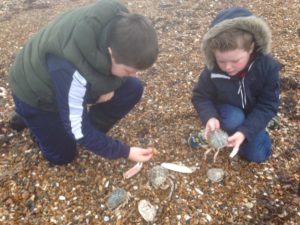
Members were soon surprised at finding many empty shells of large spider crabs, together with pincers and legs. Many of them spied with the keen eyes of two of the youngest participants, Thomas and Eoin Kearns.
Sea lemons (or sea slugs) were found amongst clumps of seaweed; including Sea Oak, Egg Wrack and Irish moss or Carragheen. It was reassuring to see that at least a small amount of Kelp was evident. Jane Hayman from the Group commented that ‘the byelaw to be introduced preventing fishing boats from entering the kelp beds off the Sussex Coast will help save this important marine habitat and hopefully allow the kelp to thrive once more’.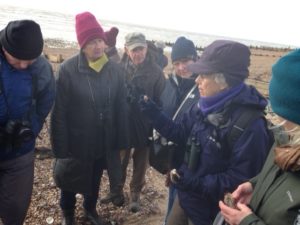
A Sea Squirt, a Starfish and also several kinds of Sponge were identified. Along with the usual egg cases of Sharks, Rays and Cuttlefish, lots of Cuttlefish bones were seen, especially baby ones.
Further along the beach the Group noticed the badly decomposed body of a Thornback Ray, a possible casualty of the recent stormy weather. On hearing the familiar ‘peep-ing’ call of the Oyster Catcher, attention was drawn to the water’s edge where many wading birds including Turnstones and Dunlins were searching for shellfish to eat. An excellent view of these birds was possible with the use of a powerful telescope, kindly provided by member Clive Hall.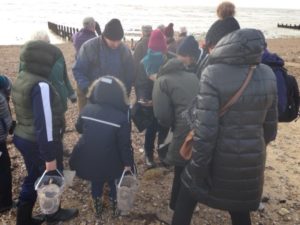
It was reassuring to find that only a small amount of plastic had been washed up but very disappointing to discover many lumps of palm oil. This edible vegetable oil comes from the fruit of oil palm trees and is used in almost 50% of packaged products found in supermarkets and also in animal feed, as well as being used as biofuel in many parts of the world (but not in the UK). It continues to be a major driver of deforestation of some of the world’s most diverse forests. Ships are regularly dumping large quantities of palm oil off the coast of Britain and although it is not poisonous to dogs, if eaten it can cause sickness and in extreme cases, pancreatitis and blockages.
A welcome stop for refreshments at Sea Lane Café gave the Group time to warm up with a hot drink, and before heading back to the starting point Tricia Hall was thanked for her time and the sharing of her considerable knowledge, which made the walk all the more interesting.
In addition to the scheduled September working party, members of Ferring Conservation Group were joined by a group of 15 enthusiastic members from ‘The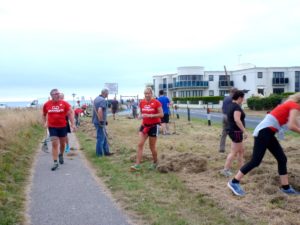 Good Gym’. This Group of volunteers from the Worthing area like to keep fit by running together to help older people with one-off tasks; to visit isolated older people and also to help with community projects. From the South Downs to the sea they run with the intention of helping those most in need.
Good Gym’. This Group of volunteers from the Worthing area like to keep fit by running together to help older people with one-off tasks; to visit isolated older people and also to help with community projects. From the South Downs to the sea they run with the intention of helping those most in need.
The task in hand was to improve the growth of wild flowers for next year after the recent grass cutting on the stretch of verge along Sea Lane in Ferring. This band of happy workers came suitably equipped with rakes as they had arranged for a car to deliver the equipment to the site ready for them to utilise in removing the grass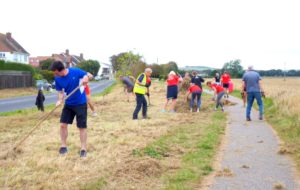 cuttings.
cuttings.
Ferring Conservation Group would like to take this opportunity to thank the Good Gym for their valuable contribution in making this laborious task much easier to complete and also much more fun with such cheerful company.
They are always looking for new runners to join them and further information can be found at: www.goodgym.org
This magnificent Wasp Spider was discovered near the Rife during the ‘Big Butterfly Count’ on 1st August. The photograph shows the female in her orb web which has a  decoration called a stabilimentum which may attract insect prey.
decoration called a stabilimentum which may attract insect prey.
Please see ‘Nature Notes’ to find out more about this fascinating spider.
Meeting in the Bluebird Café car park at the southern end of the Rife, 11 enthusiastic members of Ferring Conservation Group split themselves into two groups and set off along the west bank to endeavour to count as many butterflies and moths as they could find. Tricia Hall gave out lists for members to cross off together with sheets of 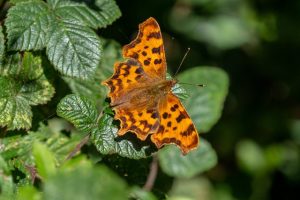 photographs to help with identification. The two Groups were hoping to see the sun come out to warm the air as this encourages butterflies to immerge from their resting places.
photographs to help with identification. The two Groups were hoping to see the sun come out to warm the air as this encourages butterflies to immerge from their resting places.
Jointly the two groups found nine different species with a total of 54 individuals in the south lagoon and 43 in the north lagoon. There were 58 Gatekeepers, over half the total found. There were only 3 Common Blues but this included a fresh female. Only one Red Admiral was seen and no Peacocks or Small Tortoiseshells. A limited number of Large and Small Whites and Speckled Wood 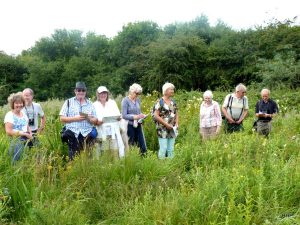 butterflies were counted and the commonest day-flying moth was a Shaded Broad-Bar.
butterflies were counted and the commonest day-flying moth was a Shaded Broad-Bar.
The results of all the butterflies and moths found have been added to the Butterfly Conservation ‘Big Butterfly Count’ survey. This nationwide survey is helping to assess the health of our environment as butterflies react very quickly to change which makes them excellent biodiversity indicators. It was launched in 2010 and has rapidly become the world’s largest survey of butterflies with over 100,000 people taking part in 2018.
Tricia commented that “more species may have been seen if the sun had come out”, as 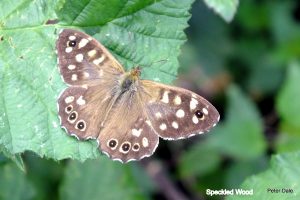 the lagoons are a mass of flowers at present, possibly benefitting from recent rain which should have provided ideal conditions. The only dragonflies seen were the reddish Common Darter, a bright blue Emperor male and an extremely tatty old female Emperor with terribly torn wings.
the lagoons are a mass of flowers at present, possibly benefitting from recent rain which should have provided ideal conditions. The only dragonflies seen were the reddish Common Darter, a bright blue Emperor male and an extremely tatty old female Emperor with terribly torn wings.
The highlight for one group was an uncommon Wasp Spider in a damp area of the north lagoon found by Graham Tuppen, one of the Group’s ultra-alert participants. This introduced species has a bright yellow and black abdomen to mimic wasps and thus avoid predators.